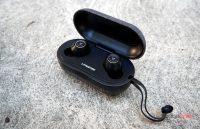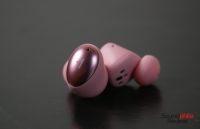Even audiophile brands are starting to offer “true wireless” earphones, following the trend inaugurated a few years ago by Apple. The HiFiMAN TWS 600 are the latest offering from HiFiMAN, who seems to be bent on bringing more wireless solutions to their portfolio. These earphones have a unique design with an unconventional tuning which make them good for specific genres, but not as “general purpose” earphones.
Disclaimer: this sample comes courtesy of Mark at HiFiMAN. The TWS 600 retail for $199. Additional info on HiFiMAN’s website.
TL;DR: recap
| Pros |
Cons |
| Original design
Comfortable Long battery life |
Upper midrange emphasis may be excessive
Low isolation |
Rating: 6.8/10
Packaging & Accessories
Packaging is quite nice. I’ve published a Headphones in Pictures article with all the details – check it out! A quick recap of what’s in the box: a UAB cable, a lot of eartips and a bonus RE-600. Yeah, there are free earphones, though it’s a limited edition for the first units as far as I’m told.
Design & Comfort

The HiFiMAN TWS 600 are certainly unusual in their design. They’re a bit bulky, with a grey colour that hides their fancy LED lighting when they are powered off. In fact the faceplate has a central physical button from which a series of rays depart; they’re all lighted with LEDs that act both as status indicators and as a fancy aesthetic device. What’s surprising about the design of the TWS 600 is that it’s bulbous; whereas most competitors nowadays uses more streamlined designs, HiFiMAN decided to go with a design full of bumps and dips on the shells.
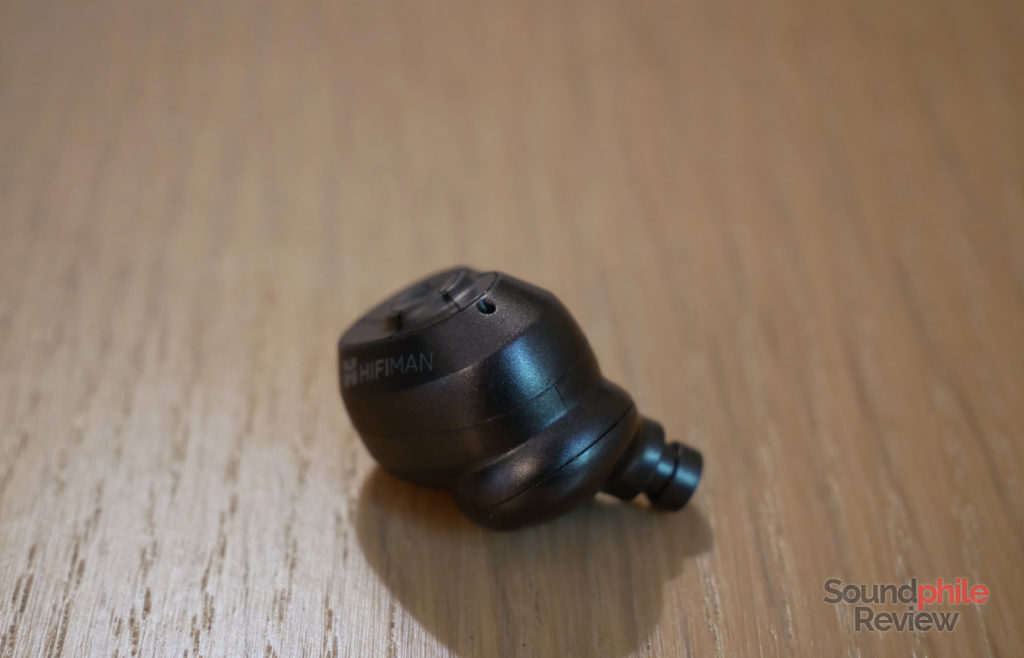
Alas the button is located on the faceplate, which means that one has to push the earphones in when pressing it – not ideal from a comfort perspective, though not tragic either. On the positive side, the button is easy to find and easy to press.
The HiFiMAN TWS 600 offer IPX4 certification, so they can take some water without damage. hey can also be used when working out, as they are resistant to sweat as well.
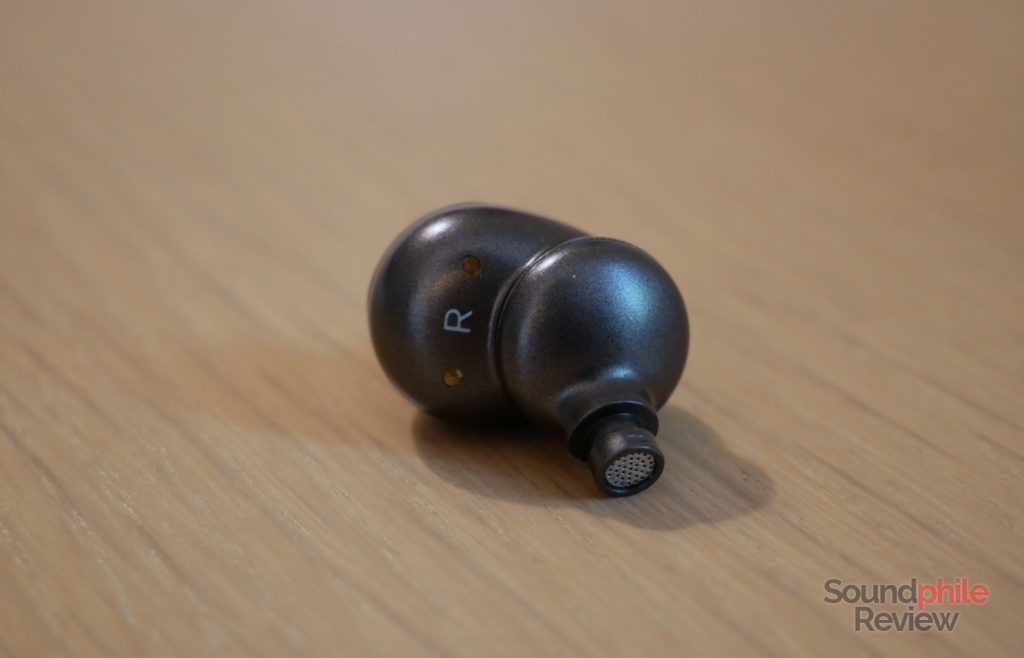
Isolation is limited irrespective of the eartips being used. In fact using them on busy streets or on public transport may require one to raise the volume, but on the other hand the relatively low isolation makes it possible to stay aware of the surroundings while enjoying the music.
Comfort is really good: the unusual design has a positive effect on how long one can wear the earphones as they have no sharp edges and a shape which fits in the ears without effort. Yes, they may be bigger than the 1More Stylish True Wireless, but they are still small enough to fit in my ears perfectly. The rounded shape also helps in not causing fatigue. I have to move them after a couple hours of use, but that’s it – they are good.

The case/cradle/dock has an oval shape, almost like an elongated egg. It is made of the same plastic as the earphones and it has the same greyish colour. The inside is black as well as the frame that goes around the middle of the case. The closing mechanism is magnetic and the case has two small flaps that one can use to open it; using just one hand is not easy, but it can be done. Inside there is a battery charge indicator; a USB Type-C connector on the back allows for charging. Overall it’s very well built and although it doesn’t look premium, it does its job and it seems robust and durable.
Extra Features & Battery Life
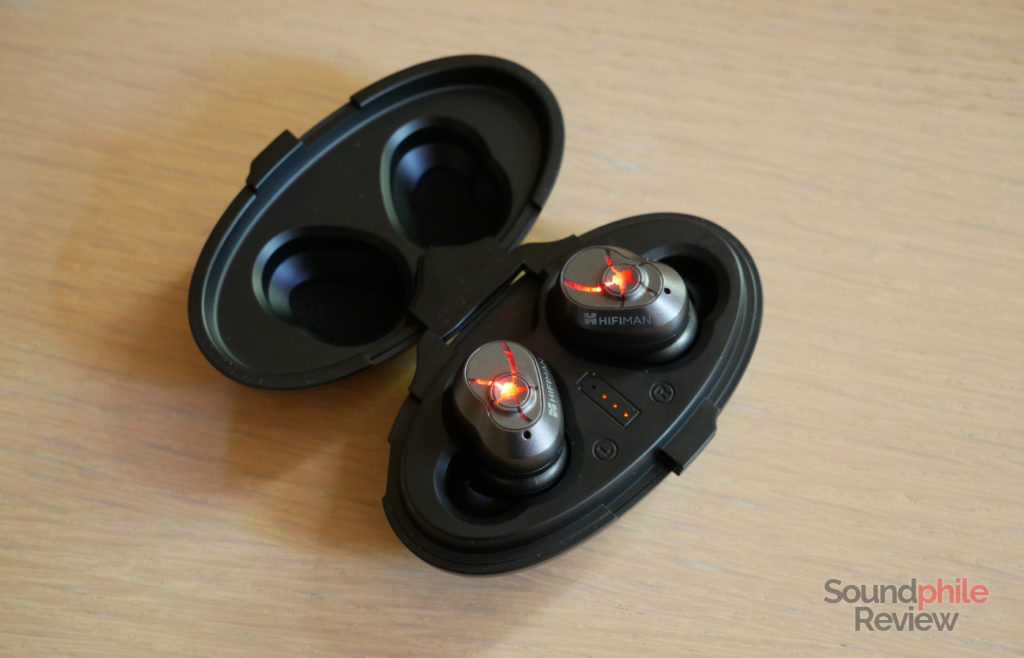
The HiFiMAN TWS 600 offer no aptX or LDAC codecs. They seem limited to SBC, which is not ideal from any perspective except compatibility as it is the standard Bluetooth codec. It is a bit of a missed opportunity.
HiFiMAN claims that the TWS 600 stay connected to the source 150 m away from it… but I could not get them to stay connected to the source while going outside my room, where other TWS earphones (e.g. RHA TrueConnect) stay perfectly connected and keep on playing music. It’s a test I always do, yet the TWS 600 could barely keep the connection alive as I stepped out of my room – they will probably fare better in an open environment, though that’s not a common use case.
A series of voice prompts and notification sounds play whenever something happens. Usually it’s a combination of voice prompts and sounds; as an example, when the connection is established a voice says “connected” and then two sharp tones play, as well as when the earphones power up; inexplicably, there is a voice prompt that says “disconnect” (why not “disconnected“?) and no tone plays. Minor inconsistencies aside, this system is good and only lacks information on the battery level.
There is a (relatively) intuitive set of commands one can use on the HiFiMAN TWS 600. One button press plays or pauses the music or accepts and ends a call irrespective of the earpiece used; pressing and holding the button for two seconds declines an incoming call or brings up the phone’s voice assistant. Double-pressing the button on the right channel will decrease the volume, while the left one will increase it. Triple-pressing the button will skip to the next track on the left earpiece and to the previous one on the right. For some reason many Chinese products have this internal inconsistency so that “lower the volume” is paired with “next track”, instead of a more intuitive “lower volume level → previous track”. That’s a cultural fact of some sort, I guess, but it can be hard to get used to it for a Westerner (as well as the complementary for a Chinese, I guess).
Battery life is rated at 5.5 hours per charge, but the TWS 600 didn’t reach that target in my tests… because they got to around 5 hours of battery life. That’s not impressive in general, as it is aligned with the current market standard of higher-tiered TWS earphones, but it’s really good nonetheless. The case can charge the earphones seven times, bringing the total to 38.5 hours according to HiFiMAN – I used them for more than a week without charging the case, so I can attest that they get close to that. HiFiMAN really did a great job with battery life on these things.
Sound & Specs
I tested the HiFiMAN TWS 600 using a Shanling M2X as the main source. It was loaded with FLAC files, mainly in 16 bit, 44.1 kHz.
HiFiMAN TWS 600 |
| Frequency response | 15 – 20,000 Hz |
| Impedance | 13 Ω |
| Sensitivity | 115 dB |
There is a bit of background noise when music is playing, and that’s especially noticeable when the track has a low volume. Luckily it’s not too noticeable.
Soundstage is more aptly described as “intimate” than wide or deep; it has some width, but it still sounds as if instruments were close to the listener. Imaging is, on the other hand, pretty good as it gives each instrument its own spot – granted it’s not laser-focused, but it’s good. Instrument separation is the weaker link in the chain as there is often a bit of mashing and mixing, though it only happens with crowded tracks.
The sound signature of the HiFiMAN TWS 600 is peculiar to say the least. We might say it is “A”-shaped, as it has a huge emphasis on the upper midrange that makes bass and treble appear recessed by comparison. It’s uncommon for sure, but this also leads to odd things.
Much like how V-shaped and L-shaped signatures can make mids sound distant or suffocated because of bass leaking over it, a midrange-first signature can make bass sound anaemic and poorly placed. That’s what happens with the TWS 600: despite bass being more than decent, it is too weak to make an impact. If we equalise some of the upper midrange out, bass appears to be well rounded, balanced and fast enough to be entertaining. It’s more than decent in standard terms, and that means it’s really good on TWS earphones. It doesn’t hit the lowest notes, though, and there is more presence in the upper region than in the other two, but its quality offsets this as it is more than good enough. Alas much of this is lost without using the equaliser, as it is drowned by the upper midrange.
The midrange is both a blessing and a curse. It’s not often that you see (ahem, hear) midrange-centric earphones, and that’s even rarer in the TWS space. Those who like to listen to music genres with a lot of vocals, or guitars or other instruments would surely appreciate added emphasis on midrange. On the other hand, though, the TWS 600’s signature is such that it displays the upper midrange area most prominently, to the point that it almost covers anything else and distorts sound. Let me explain that: if you listen to Stevie Ray Vaughan’s Dirty Pool you can clearly hear the guitar playing in all its glory, but then when SRV starts singing it seems like there’s something wrong – his voice is almost nasal and lacks the usual scratchiness and rawness. It sounds as if the lower range has been taken away, or as if music was playing on one of those cheap portable radios I used as a kid in the ’90s. If one takes ~2.5 dB away from the 2 kHz area using an equaliser the voice goes back to normal and the other parts (lower midrange and bass) appear to be present again. I don’t question the fact that there may be specific songs and genres where this added emphasis could be beneficial; most tracks will sound a bit off, though. And this is despite very good technical ability: speed is very good, detail is phenomenal in this price range of the TWS market, physicality is remarkable for a TWS.
Treble is thankfully not as prominent as the upper midrange, so it is not fatiguing. It’s still very much present in the mix and it’s easy to hear it. It has decent extension which lends it some air, though I wouldn’t describe as it “really airy”. It has a great level of detail, which makes it really attractive as it comes with a lot of things to hear; you won’t hear all micro-details, but the amount of detail is fairly impressive for TWS earphones.
HiFiMAN TWS 600 Comparisons
Let’s compare the HiFiMAN TWS 600 to other TWS earphones:
- RHA TrueConnect: the TrueConnect are more V-shaped, but in a sense they’re as distant from neutrality as the TWS 600. Their bass is much more prominent, but also much deeper and a bit faster; it provides much more body than the TWS 600’s. Midrange is more recessed, but also more balanced, with its lower range that is much easier to hear and the upper range that is much less prominent, leading to an overall more enjoyable and balanced presentation. Treble is a bit more prominent, but also more detailed, with a whole lot of detail being presented to the listener. Soundstage is noticeably wider on the TrueConnect, but imaging is comparable; instrument separation, on the other hand, is superior on the TrueConnect.
- Lypertek Tevi: theLypertek Tevi seem to take the best of both worlds and reach a great compromise between the TWS 600 and the TrueConnect with a neutral-leaning tuning that will please many audiophiles. Bass is halfway between the TWS 600 and the TrueConnect, so it appears more-or-less neutral in terms of quantity, without a lot of depth but with good control and detail. Midrange is more prominent than on the RHA, but way less emphasised than on the HiFiMAN, therefore it sounds well-balanced both in the mix and in its own internal balance (there’s no emphasis on any specific part). Treble is similar to the TWS 600, so it is detailed but not extremely so, and it appears slightly behind the midrange. Overall the sound is well-detailed. Soundstage is larger than on the TWS 600, but imaging is not on par and instrument separation is worse.
Final Thoughts
If you are after a neutral tuning and you are willing to use some equalisation, the HiFiMAN TWS 600 are actually really good. They offer good TWS features (comfort, connection quality, additional features for smartphones) and they top it with good technical ability and a fast, lively sound. They actually offer lots to love. Their stock tuning will probably not appeal to lots of people, though, leaving it to those who are really into bright tuning. I hope they will offer a more neutrally-tuned revision in the future, because the potential is really high.
Things being as they are, I can only recommend the HiFiMAN TWS 600 to those who are okay with EQing their headphones or who like really bright signatures. The TWS 600 are surely different, and that’s a welcome thing, but alas in their stock state they’re different in a way that few will appreciate.




